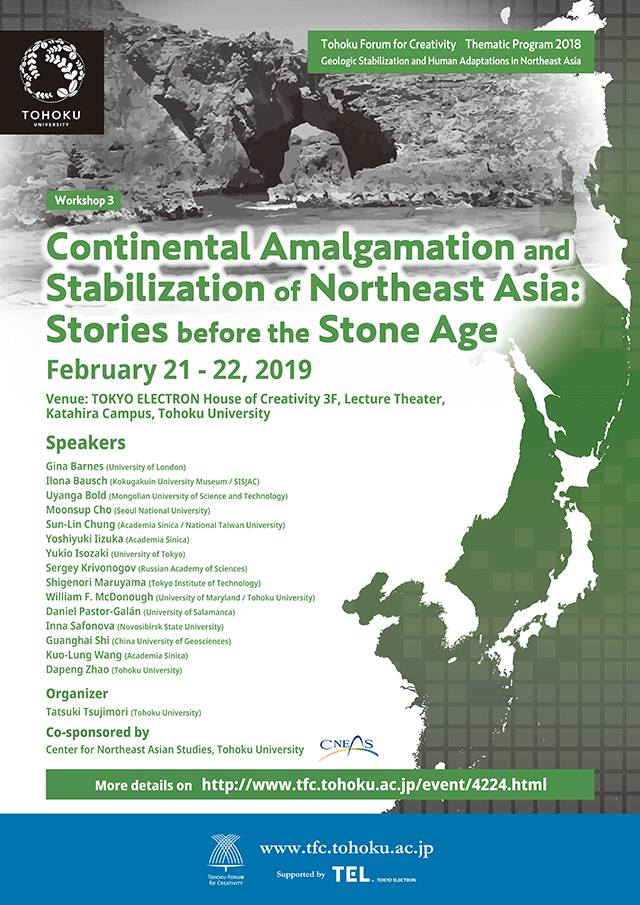Workshop 3: Continental Amalgamation and Stabilization of Northeast Asia: Stories before the Stone Age
Information
Eurasia, including the Northeast Asian region, was formed by amalgamation of several continental and micro–continental blocks. For example, convergent plate motion beginning some 320–210 million years ago (Ma) generated the Tongbai–Dabie–Sulu (east–central China) –Imjingang–Gyeonggi (central Korea) –Renge–Suo (Southwestern Japan) –Sikhote–Alin orogen along the paleo–Pacific edge of cratonal Asia. This amalgamated belt reflects collision between the Sino–Korean and Yangtze cratons on the SW portion, and accretion of outboard oceanic arcs with some sialic fragments against the NE margin. Accretion, deformation, and metamorphism of the Himalayan–Tibetan orogenic belt took place during the approximate interval 50–15 Ma, reflecting convergence between the Indian Shield and the nonsubducted Asian lithosphere at about 50–70 Ma. Those two major orogens are characterized by the multiple events involving accretion of outboard oceanic arcs and microcontinental fragments against the Asian lithosphere. In Northeast Asia, the present–day environment of the Earth's surface and biosphere including our human activities are strongly affected by geological and geomorphological characteristics, which were caused by continental amalgamation and stabilization of Northeast Asia before the Stone Age. Specific focus in this workshop includes “lithospheric and crustal evolution and stabilization”. However, this workshop also aims to provide opportunities to link geological sciences to ecology, archeology, and socio–cultural anthropology and to systematize interdisciplinary knowledge on Northeast Asia.
Date
February 21, 2019 – February 22, 2019
Venue
TOKYO ELECTRON House of Creativity 3F, Lecture Theater, Katahira Campus, Tohoku University [Access]
Speakers [Dec. 6, 2018 Updated]
Gina Barnes (University of London)
Ilona Bausch (Kokugakuin University Museum / SISJAC)
Uyanga Bold (Mongolian University of Science and Technology)
Moonsup Cho (Seoul National University)
Yoshiyuki Iizuka (Academia Sinica)
Yukio Isozaki (University of Tokyo)
Sergey Krivonogov (Russian Academy of Sciences)
Shigenori Maruyama (Tokyo Institute of Technology)
William F. McDonough (University of Maryland / Tohoku University)
Daniel Pastor–Galán (University of Salamanca)
Inna Safonova (Novosibirsk State University)
Guanghai Shi (China University of Geosciences)
Kuo–Lung Wang (Academia Sinica)
Dapeng Zhao (Tohoku University)
Time Schedule [Feb 15, 2019 Updated]
- Thursday, February 21, 2019
- Plenary Session
- 10:30 – 10:40
- Welcome address
- Hiroki Takakura (Workshop 4 organizer, Tohoku University)
- Tatsuki Tsujimori (Workshop 3 organizer, Tohoku University)
- Florian Stammler (University of Lapland)
- Plenary Lecture
- 10:40 – 11:20
- Shigenori Maruyama (Tokyo Institute of Technology)
- Global Climate Change in the Past and Near Future: A
Geological Perspective
- 11:20 – 12:00
- Hugh Beach (Uppsala University)
- Sustaining Arctic Livelihoods and Sustaining Anthropology in the Anthropocene
- 12:00 – 13:30
- Lunch break
- Session 1: Amalgamation of Asia
3–min remarks by Tatsuki Tsujimori (Tohoku University) - 13:30 – 14:00
- Daniel Pastor–Galan (University of Salamanca)
- The Supercontinent Cycle and the Growth of East Asia
- 14:00 – 14:30
- Moonsup Cho (Seoul National University)
- A New Tectonostratigraphic Scheme of the Korean Peninsula
- 14:30 – 15:00
- Yukio Isozaki (University of Tokyo)
- Nipponides vs. Altaids
- 15:00 – 15:30
- Discussion
- 15:30 – 16:00
- Coffee Break
- Session 2: “Second Continent” beneath Asia
3–min remarks by Tatsuki Tsujimori (Tohoku University) - 16:00 – 16:30
- Shigenori Maruyama (Tokyo Institute of Technology)
- Concept of the Second Continent – Why Important?
- 16:30 – 17:00
- Dapeng Zhao (Tohoku University)
- Seismic Imaging of the Second Continent
- 17:00 – 17:30
- William F. McDonough (University of Maryland / Tohoku University)
- Testing a Proposed “Second Continent” beneath Eastern China Using Geoneutrino Measurements
- 18:00 – 20:00
- Banquet
- Friday, February 22, 2019
- Session 3: Crossover among Geological Sciences and Archeology
3–min remarks by Tatsuki Tsujimori (Tohoku University)
- 09:30 – 10:00
- Guanghai Shi (China University of Geosciences)
- The Myanmar Jadeite Jade (Feicui) and Introduction of the Chinese Jadeite Culture
- 10:00 – 10:30
- Yoshiyuki Iizuka (Academia Sinica)
- Geochemical Sourcing Study of Nephrite Jade in Southeast and East Asian Prehistory
- 10:30 – 11:00
- Ilona Bausch (Kokugakuin University Museum / SISJAC)
- Not Merely an “Accessory”: The Role of Jade Objects in Jomon Society
- 11:00 – 11:30
- Gina Barnes (University of London)
- Sanukite, Green Tuff, and Obsidian: Archaeological Stones and their Geological Sources
- 11:30 – 12:00
- Sergey Krivonogov (Siberian Branch of the Russian Academy of Sciences)
- The History of the Aral Sea: Implications from Multi–Disciplinary Study
- Session 4: COAB and PAC–Type Margin
3–min remarks by Tatsuki Tsujimori (Tohoku University)
- 13:30 – 14:00
- Uyanga Bold (Mongolian University of Science and Technology)
- Precambrian to Early Paleozoic Geology of the Central Asian Orogenic Belt
- 14:00 – 14:30
- Kuo–Lung Wang (Academia Sinica)
- Ancient Continents among the Central Asia Orogenic Belt: Evidence from Lithospheric Mantle Xenoliths
- 14:30 – 15:00
- Inna Safonova (Novosibirsk State University)
- Tectonic Erosion at Pacific–Type Convergent Margins
- 15:00 – 15:30
- Discussion with coffee
**All speakers are welcoming to join the half–day observational study guided
by Dr. Sebastian Boret (Anthropologist, Tohoku University) at 12:00 – 17:00 on February 23, 2019.
Poster: Download [PDF]
Abstract [Apr. 9, 2019 Updated]
- Download [PDF]
Contact
Tomoko Yaginuma
tomoko.yaginuma.b4*tohoku.ac.jp (change * to @)
Organizer [Nov. 22, 2018 Updated]
Tatsuki Tsujimori (Tohoku University)
Co–sponsored by [Dec. 6, 2018 Updated]
Poster [Dec. 14, 2018 Updated]
- Download [PDF]

